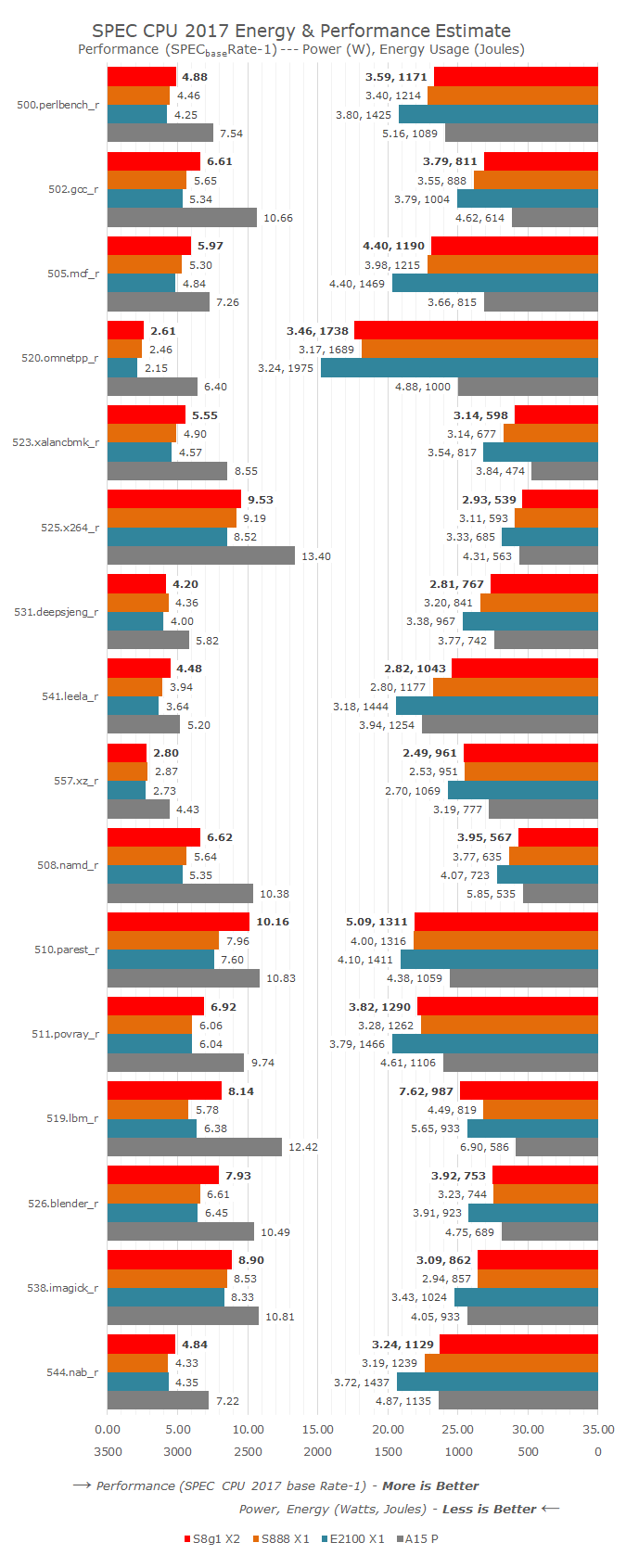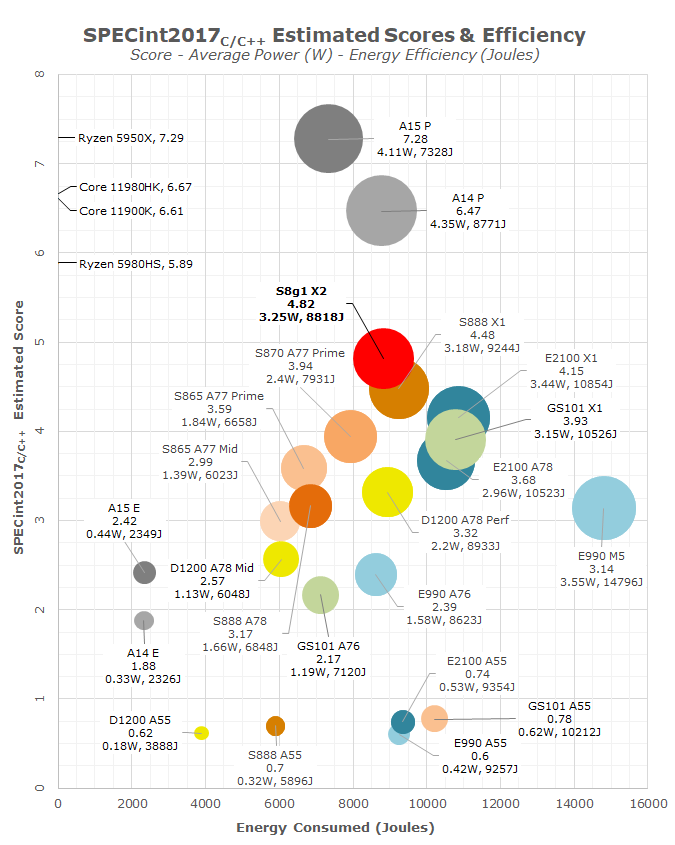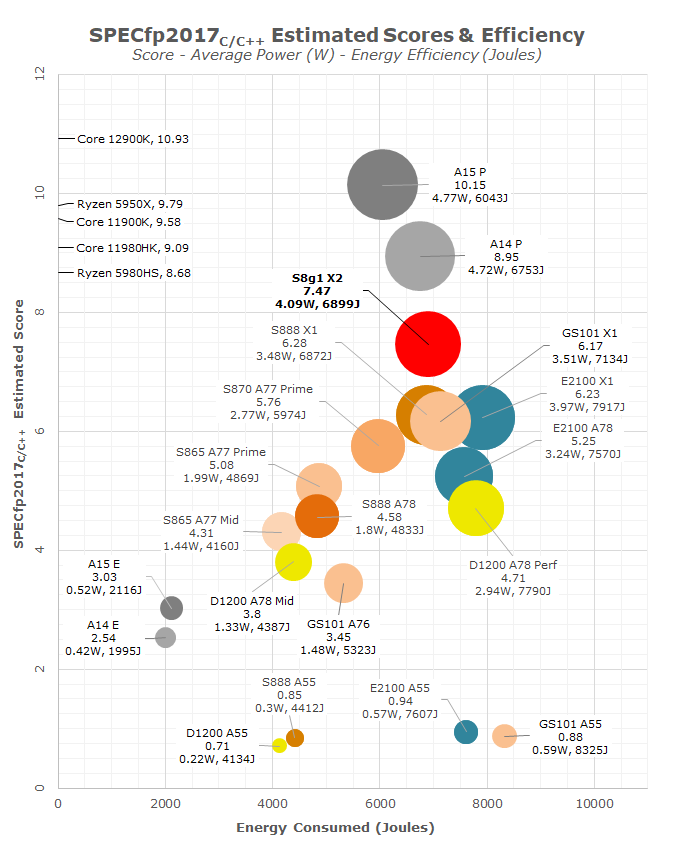The Snapdragon 8 Gen 1 Performance Preview: Sizing Up Cortex-X2
by Dr. Ian Cutress on December 14, 2021 8:00 AM ESTTesting the Cortex-X2: A New Android Flagship Core
Improving on the Cortex-X1 by switching to the Arm v9 architecture and increasing the core resources, both Arm and Qualcomm are keen to promote that the Cortex-X2 offers better performance and responsiveness than previous CPU cores. The small frequency bump from 2.85 GHz to 3.00 GHz will add some of that performance, however the question is always if the new manufacturing process coupled with the frequency increase allows for better power efficiency when running these workloads. Our standard analysis tool here is SPEC2017.
Running through some of these numbers, there are healthy gains to the core, and almost everything has a performance lift.
On the integer side (from 500.perlbench to 557.xr), there are good gains for gcc (+17%), mcf (+13%), xalancbmk (+13%), and leela (+14%), leading to an overall +8% improvement. Most of these integer tests involve cache movement and throughput, and usually gains in sub-tests like gcc can help a wide range of regular user workloads.
Looking at power and energy for the integer benchmarks, we’re seeing the X2 consume more instantaneous power on almost all the tests, but the efficiency is kicking in. That overall 8% performance gain is taking 5% less total energy, but on average requires 2% more peak power.
If we put this core up against all the other performance cores we test, we see that 8% jump in performance for 5% less energy used, and the X2 stands well above the X1 cores of the previous generation, especially those in non-Snapdragon processors. There is still a fundamental step needed to reach the Apple cores, even the previous-generation A14 performance core, which scores 34% higher for the same energy consumed (albeit on average another 34% peak power).
Just on these numbers, Qualcomm’s +20% performance or +30% efficiency doesn’t bare fruit, but the floating point numbers are significantly different.
Several benchmarks in 2017fp are substantially higher on the X2 this generation. +17% on namd for example would point to execution performance increases, but +28% in parest, +41% in lbm and +20% in blender showcases a mix of execution performance and memory performance. Overall we’re seeing +19% performance, which is nearer Qualcomm’s 20% mark. Note that this comes with an almost identical amount of energy consumed relative to the X1 core in the S888, with a difference of just 0.2%.
The major difference however is the average power consumed. For example, our biggest single test gain in 519.lbm is +41%, but where the S888 averages 4.49 watts, the new X2 core averages 7.62 watts. That’s a 70% increase in instantaneous power consumer, and realistically no single core in a modern smartphone should draw that much power. The reason why the power goes this high is because lbm leverages the memory subsystem, especially that 6 MiB L3 cache and relies on the 4 MiB system level cache, all of which consumes power. Overall in the lbm test, the +41% performance costs +20% energy, so efficiency is still +16% in this test. Some of the other tests, such as parest and blender, also follow this pattern.
Comparing against the competition, the X2 core does make a better generation jump when it comes to floating point performance. It will be interesting to see how other processors enable the X2 core, especially MTK’s flagship at slightly higher frequency, on TSMC N4, but also if it has access to a full 14 MiB combination of caches as we suspect, that could bring the power draw during single core use a lot higher. It will be difficult to tease out exactly who wins what where based on implementation vs. process node, but it will be a fun comparison to make when we look purely at the X2 vs. X2 cores.
Unfortunately due to how long SPEC takes to run (1h30 on the X2), we were unable to test on the A710/A510. We’ll have to wait to see when we get a retail unit.













169 Comments
View All Comments
GeoffreyA - Wednesday, December 15, 2021 - link
Since about Kit Kat or so, the bytecode of an Android app is compiled to native code at install time. But doubtless C++ would still be faster because Java overdoes object-oriented style and dynamic allocation. C/C++ code can work in Android using the NDK, but it appears to be a nightmare getting it latched in. Sometimes I wonder what they were thinking when they picked Java as their language.Meteor2 - Friday, December 17, 2021 - link
They were thinking about the number of developers who could code it...TheinsanegamerN - Friday, December 17, 2021 - link
Developer support, ease of transition, and flexibility.Chaser - Tuesday, December 14, 2021 - link
Before, I used to care about these SOC improvements/benchmarks, etc. But I don't play games on smartphones. All I care about today is battery life improvements, not performance.Alistair - Tuesday, December 14, 2021 - link
That's why I switched to Apple. I get battery life and efficiency improvements, and CPU improvements. The only highlight for Snapdragon is GPU. CPU improvements are almost non-existent this year, again. Same for several years, they get farther and farther behind Apple in CPU.flyingpants265 - Thursday, December 16, 2021 - link
Yeah, but everything else about it sucks.Alistair - Saturday, December 18, 2021 - link
just browsing the web and using apps that are the same on all platforms, and doing it fasterKangal - Sunday, December 19, 2021 - link
Apple has a long history, that whenever their next chipset offers more efficiency, they counteract this by using a new (power hungry) feature.For instance, newer 5G modem, 120Hz screen, higher resolution, or more processing demand in their next software.
And at times, they even reduce the battery capacity. This saves weight off the phone, and they counteract this by adding other components like more cameras, or heavier glass construction.
All in all, the iPhones don't gain more battery life, they follow a general trend, and there are some outliers there (eg iPhone 6S+ and iPhone 13 Max).
TheinsanegamerN - Friday, December 17, 2021 - link
Budget phones like the moto g power annialate apple in real life battery benchmarks for a fraction of the price.Alistair - Tuesday, December 14, 2021 - link
I'll all in on Mediatek then, this was disappointing. Can't wait for Mediatek comparisons!